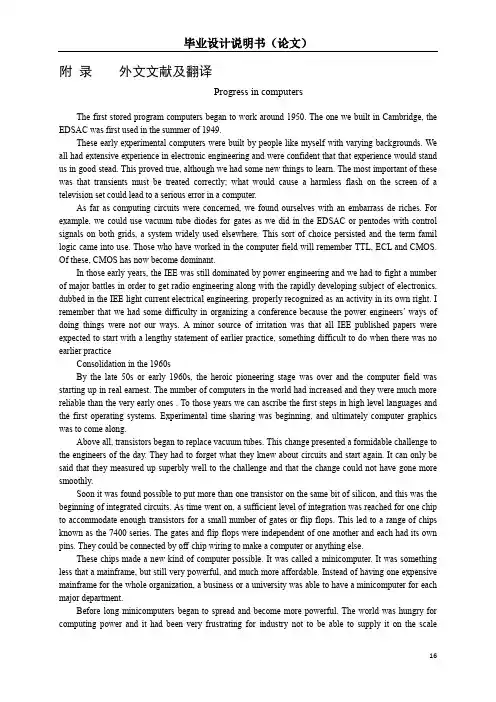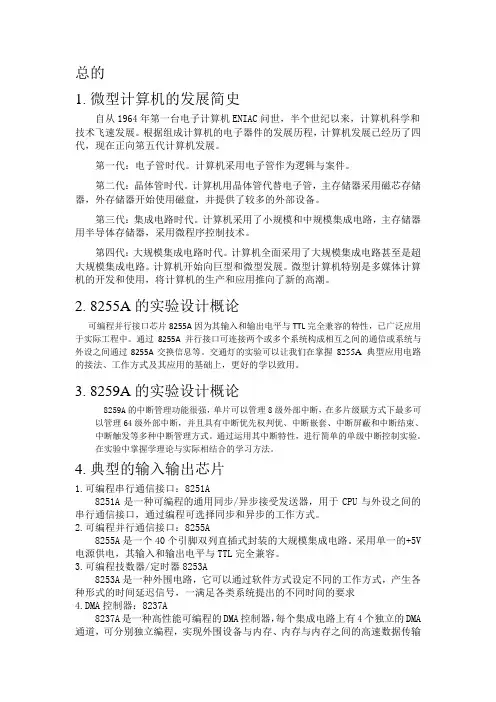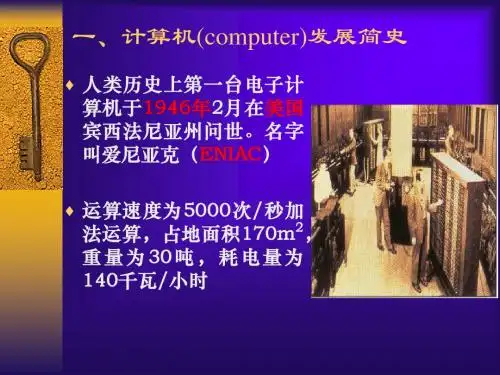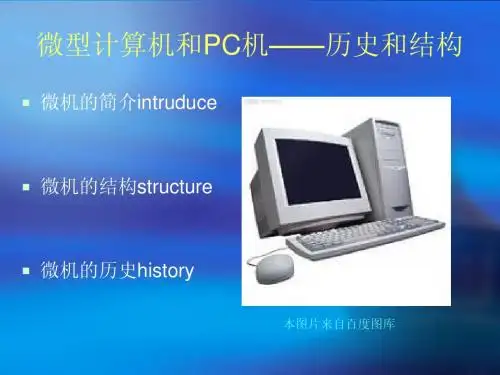计算机专业外文资料翻译----微机发展简史
- 格式:docx
- 大小:32.28 KB
- 文档页数:6

附录外文文献及翻译Progress in computersThe first stored program computers began to work around 1950. The one we built in Cambridge, the EDSAC was first used in the summer of 1949.These early experimental computers were built by people like myself with varying backgrounds. We all had extensive experience in electronic engineering and were confident that that experience would standus in good stead. This proved true, although we had some new things to learn. The most important of these was that transients must be treated correctly; what would cause a harmless flash on the screen of a television set could lead to a serious error in a computer.As far as computing circuits were concerned, we found ourselves with an embarrass de riches. For example, we could use vacuum tube diodes for gates as we did in the EDSAC or pentodes with control signals on both grids, a system widely used elsewhere. This sort of choice persisted and the term famillogic came into use. Those who have worked in the computer field will remember TTL, ECL and CMOS. Of these, CMOS has now become dominant.In those early years, the IEE was still dominated by power engineering and we had to fight a number of major battles in order to get radio engineering along with the rapidly developing subject of electronics. dubbed in the IEE light current electrical engineering. properlyrecognized as an activity in its own right. I remember that we had some difficulty in organizing a co nference because the power engineers‟ ways of doing things were not our ways. A minor source of irritation was that all IEE published papers were expected to start with a lengthy statement of earlier practice, something difficult to do when there was no earlier practiceConsolidation in the 1960sBy the late 50s or early 1960s, the heroic pioneering stage was over and the computer field was starting up in real earnest. The number of computers in the world had increased and they were much more reliable than the very early ones . To those years we can ascribe the first steps in high level languages and the first operating systems. Experimental time-sharing was beginning, and ultimately computer graphics was to come along.Above all, transistors began to replace vacuum tubes. This change presented a formidable challenge to the engineers of the day. They had to forget what they knew about circuits and start again. It can only be said that they measured up superbly well to the challenge and that the change could not have gone more smoothly.Soon it was found possible to put more than one transistor on the same bit of silicon, and this was the beginning of integrated circuits. As time went on, a sufficient level of integration was reached for one chip to accommodate enough transistors for a small number of gates or flip flops. This led to a range of chips known as the 7400 series. The gates and flip flops were independent of one another and each had its own pins. They could be connected by off-chip wiring to make a computer or anything else.These chips made a new kind of computer possible. It was called a minicomputer. It was something less that a mainframe, but still very powerful, and much more affordable. Instead of having one expensive mainframe for the whole organization, a business or a university was able to have a minicomputer for each major department.Before long minicomputers began to spread and become more powerful. The world was hungry for computing power and it had been very frustrating for industry not to be able to supply it on the scalerequired and at a reasonable cost. Minicomputers transformed the situation.The fall in the cost of computing did not start with the minicomputer; it had always been that way. This was what I meant when I referred in my abstract to inflation in the computer industry …going the other way‟. As time goes on people get more for their money, not less.Research in Computer Hardware.The time that I am describing was a wonderful one for research in computer hardware. The user of the 7400 series could work at the gate and flip-flop level and yet the overall level of integration was sufficient to give a degree of reliability far above that of discreet transistors. The researcher, in a university orelsewhere, could build any digital device that a fertile imagination could conjure up. In the Computer Laboratory we built the Cambridge CAP, a full-scaleminicomputer with fancy capability logic.The 7400 series was still going strong in the mid 1970s and was used for the Cambridge Ring, a pioneering wide-band local area network. Publication of the design study for the Ring came just before the announcement of the Ethernet. Until these two systems appeared, users had mostly been content with teletype-based local area networks. Rings need high reliability because, as the pulses go repeatedly round the ring, they must be continually amplified and regenerated. It was the high reliability provided by the 7400 series of chips that gave us the courage needed to embark on the project for the Cambridge Ring.The RISC Movement and Its AftermathEarly computers had simple instruction sets. As time went on designers of commercially available machines added additional features which they thought would improve performance. Few comparative measureme nts were done and on the whole the choice of features depended upon the designer‟s intuition.In 1980, the RISC movement that was to change all this broke on the world. The movement opened with a paper by Patterson and ditzy entitled The Case for the Reduced Instructions Set Computer.Apart from leading to a striking acronym, this title conveys little of the insights into instruction set design which went with the RISC movement, in particular the way it facilitated pipelining, a system whereby several instructions may be in different stages of execution within the processor at the same time. Pipelining was not new, but it was new for small computersThe RISC movement benefited greatly from methods which had recently become available for estimating the performance to be expected from a computer design without actually implementing it. I refer to the use of a powerful existing computer to simulate the new design. By the use of simulation, RISC advocates were able to predict with some confidence that a good RISC design would be able to out-perform the best conventional computers using the same circuit technology. This prediction was ultimately born out in practice.Simulation made rapid progress and soon came into universal use by computer designers. In consequence, computer design has become more of a science and less of an art. Today, designers expect to have a roomful of, computers available to do their simulations, not just one. They refer to such a roomful by the attractive name of computer farm.The x86 Instruction SetLittle is now heard of pre-RISC instruction sets with one major exception, namely that of the Intel 8086 and its progeny, collectively referred to as x86. This has become the dominant instruction set and the RISC instruction sets that originally had a considerable measure of success are having to put up a hard fight for survival.This dominance of x86 disappoints people like myself who come from the research wings. both academic and industrial. of the computer field. No doubt, business considerations have a lot to do with the survival of x86, but there are other reasons as well. However much we research oriented people would liketo think otherwise. high level languages have not yet eliminated the use of machine code altogether. We need to keep reminding ourselves that there is much to be said for strict binary compatibility with previous usage when that can be attained. Nevertheless, things might have been different if Intel‟s major attempt to produce a good RISC chip had been more successful. I am referring to the i860 (not the i960, which was something different). In many ways the i860 was an excellent chip, but its software interface did not fit it to be used in aworkstation.There is an interesting sting in the tail of this apparently easy triumph of the x86 instruction set. It proved impossible to match the steadily increasing speed of RISC processors by direct implementation ofthe x86 instruction set as had been done in the past. Instead, designers took a leaf out of the RISC book; although it is not obvious, on the surface, a modern x86 processor chip contains hidden within it a RISC-style processor with its own internal RISC coding. The incoming x86 code is, after suitable massaging, converted into this internal code and handed over to the RISC processor where the critical execution is performed. In this summing up of the RISC movement, I rely heavily on the latest edition of Hennessy and Patterson‟s books on computer design as my supporting authority; see in particular Computer Architecture, third edition, 2003, pp 146, 151-4, 157-8.The IA-64 instruction set.Some time ago, Intel and Hewlett-Packard introduced the IA-64 instruction set. This was primarily intended to meet a generally recognized need for a 64 bit address space. In this, it followed the lead of the designers of the MIPS R4000 and Alpha. However one would have thought that Intel would have stressed compatibility with the x86; the puzzle is that they did the exact opposite.Moreover, built into the design of IA-64 is a feature known as predication which makes it incompatible in a major way with all other instruction sets. In particular, it needs 6 extra bits with each instruction. This upsets the traditional balance between instruction word length and information content, and it changes significantly the brief of the compiler writer.In spite of having an entirely new instruction set, Intel made the puzzling claim that chips based on IA-64 would be compatible with earlier x86 chips. It was hard to see exactly what was meant.Chips for the latest IA-64 processor, namely, the Itanium, appear to have special hardware for compatibility. Even so, x86 code runs very slowly.Because of the above complications, implementation of IA-64 requires a larger chip than is required for more conventional instruction sets. This in turn implies a higher cost. Such at any rate, is the received wisdom, and, as a general principle, it was repeated as such by Gordon Moore when he visited Cambridge recently to open the Betty and Gordon Moore Library. I have, however, heard it said that the matter appears differently from within Intel. This I do not understand. But I am very ready to admit that I am completely out of my depth as regards the economics of the semiconductor industry.Shortage of ElectronsAlthough shortage of electrons has not so far appeared as an obvious limitation, in the long term it may become so. Perhaps this is where the exploitation of non-conventional CMOS will lead us. However, some interesting work has been done. notably by HuronAmend and his team working in the Cavendish Laboratory. on the direct development of structures in which a single electron more or less makes the difference between a zero and a one. However very little progress has been made towards practical devices that could lead to the construction of a computer. Even with exceptionally good luck, many tens of years must inevitably elapse before a working computer based on single electron effects can be contemplated.微机发展简史第一台存储程序的计算开始出现于1950前后,它就是1949年夏天在剑桥大学,我们创造的延迟存储自动电子计算机(EDSAC)。

总的1.微型计算机的发展简史自从1964年第一台电子计算机ENIAC问世,半个世纪以来,计算机科学和技术飞速发展。
根据组成计算机的电子器件的发展历程,计算机发展已经历了四代,现在正向第五代计算机发展。
第一代:电子管时代。
计算机采用电子管作为逻辑与案件。
第二代:晶体管时代。
计算机用晶体管代替电子管,主存储器采用磁芯存储器,外存储器开始使用磁盘,并提供了较多的外部设备。
第三代:集成电路时代。
计算机采用了小规模和中规模集成电路,主存储器用半导体存储器,采用微程序控制技术。
第四代:大规模集成电路时代。
计算机全面采用了大规模集成电路甚至是超大规模集成电路。
计算机开始向巨型和微型发展。
微型计算机特别是多媒体计算机的开发和使用,将计算机的生产和应用推向了新的高潮。
2.8255A的实验设计概论可编程并行接口芯片8255A因为其输入和输出电平与TTL完全兼容的特性,已广泛应用于实际工程中。
通过8255A并行接口可连接两个或多个系统构成相互之间的通信或系统与外设之间通过8255A交换信息等。
交通灯的实验可以让我们在掌握8255A 典型应用电路的接法、工作方式及其应用的基础上,更好的学以致用。
3.8259A的实验设计概论8259A的中断管理功能很强,单片可以管理8级外部中断,在多片级联方式下最多可以管理64级外部中断,并且具有中断优先权判优、中断嵌套、中断屏蔽和中断结束、中断触发等多种中断管理方式。
通过运用其中断特性,进行简单的单级中断控制实验。
在实验中掌握学理论与实际相结合的学习方法。
4.典型的输入输出芯片1.可编程串行通信接口:8251A8251A是一种可编程的通用同步/异步接受发送器,用于CPU与外设之间的串行通信接口,通过编程可选择同步和异步的工作方式。
2.可编程并行通信接口:8255A8255A是一个40个引脚双列直插式封装的大规模集成电路。
采用单一的+5V 电源供电,其输入和输出电平与TTL完全兼容。
3.可编程技数器/定时器8253A8253A是一种外围电路,它可以通过软件方式设定不同的工作方式,产生各种形式的时间延迟信号,一满足各类系统提出的不同时间的要求4.DMA控制器:8237A8237A是一种高性能可编程的DMA控制器,每个集成电路上有4个独立的DMA 通道,可分别独立编程,实现外围设备与内存、内存与内存之间的高速数据传输5.中断控制器:8259A8259A是一种专门为控制优先级中断而设计的集成电路。



微型计算机发展史
随着科学技术的不断发展,计算机的性能逐渐得到提高,微型计算机作为计算机革命的标志,在社会上得到了广泛的应用。
计算机发展史,要从20世纪50年代说起。
1951年,英国科学家迪米特里·埃尔德提出了装有核心存储器的计算机原理,这就是计算机的起源。
1956年,美国IBM推出的IBM702系列,是世界上第一台型号标准的大型机,它采用了核心存储器储存程序,实现了程序储存,而且它的数据处理速度达到5000次/秒,是当时的最大计算机。
随后,IBM推出了第一台微型计算机,1973年IBM推出了首款微型计算机,IBM5100,它比当时的大型机小了几十倍,但它也拥有大型机的功能,售价一万七千美元。
后来,微型计算机的价格逐渐降低,性能也得到大大提高,随着微型计算机的发展,现在的微型计算机有多种结构形式,例如电脑、笔记本电脑、平板电脑等,电脑和笔记本电脑是目前应用最为广泛的微型计算机。
电脑的发展,也改变了人类的生活方式,它不仅提高了用户的工作效率,而且拓展了人类的智慧,能够有效地处理和分析大量数据,实现快速的信息计算,帮助人类解决许多复杂的问题。



毕业设计(论文)外文翻译题目微机发展简史专业电子信息工程班级01学生李嘉亮指导教师邓亚玲西安理工大学高科学院2011 年微机发展简史IEEE的论文剑桥大学,2004/2/5莫里斯威尔克斯计算机实验室剑桥大学第一台存储程序的计算开始出现于1950前后,它就是1949年夏天在剑桥大学,我们创造的延迟存储自动电子计算机(EDSAC)。
最初实验用的计算机是由象我一样有着广博知识的人构造的。
我们在电子工程方面都有着丰富的经验,并且我们深信这些经验对我们大有裨益。
后来,被证明是正确的,尽管我们也要学习很多新东西。
最重要的是瞬态一定要小心应付,虽然它只会在电视机的荧幕上一起一个无害的闪光,但是在计算机上这将导致一系列的错误。
在电路的设计过程中,我们经常陷入两难的境地。
举例来说,我可以使用真空二级管做为门电路,就象在EDSAC中一样,或者在两个栅格之间用带控制信号的五级管,这被广泛用于其他系统设计,这类的选择一直在持续着直到逻辑门电路开始应用。
在计算机领域工作的人都应该记得TTL,ECL和CMOS,到目前为止,CMOS已经占据了主导地位。
在最初的几年,IEE(电子工程师协会)仍然由动力工程占据主导地位。
为了让IEE 认识到无线工程和快速发展的电子工程并行发展是它自己的一项权利,我们不得不面对一些障碍。
由于动力工程师们做事的方式与我们不同,我们也遇到了许多困难。
让人有些愤怒的是,所有的IEE出版的论文都被期望以冗长的早期研究的陈述开头,无非是些在早期阶段由于没有太多经验而遇到的困难之类的陈述。
60年代的巩固阶段60年代初,个人英雄时代结束了,计算机真正引起了重视。
世界上的计算机数量已经增加了许多,并且性能比以前更加可靠。
这些我认为归因与高级语言的起步和第一个操作系统的诞生。
分时系统开始起步,并且计算机图形学随之而来。
综上所述,晶体管开始代替正空管。
这个变化对当时的工程师们是个不可回避的挑战。
他们必须忘记他们熟悉的电路重新开始。

微机的发展史微机是指个人计算机,它是计算机技术发展的重要里程碑之一。
本文将从微机的起源、发展和未来前景三个方面,介绍微机的发展史。
一、微机的起源20世纪60年代末,随着集成电路技术的发展,计算机体积逐渐缩小,价格逐渐下降。
1969年,美国一家计算机公司推出了第一台个人计算机,这标志着微机的诞生。
当时的微机还非常庞大,只能由专业人员操作,价格昂贵,普通人难以接触。
二、微机的发展20世纪70年代,随着微电子技术的迅猛发展,微机开始进入大众视野。
1976年,美国的一家创业公司推出了一款名为“苹果”的个人计算机,这款计算机的问世引发了一场个人计算机革命。
个人计算机从此开始走向普及,成为人们生活和工作中必不可少的工具。
在80年代,微机的发展进入了一个高速发展的时期。
各国纷纷投入资金和人力资源进行研发,推动了微机技术的不断创新。
1981年,IBM公司发布了第一台个人计算机,这款计算机的操作系统开放给其他厂商使用,从而推动了个人计算机的标准化和普及。
个人计算机市场竞争激烈,各家厂商相继推出了各种型号的微机,不断满足用户的需求。
90年代,随着互联网的兴起,微机的功能进一步扩展。
人们可以通过微机上网冲浪、发送电子邮件等,微机的作用不再局限于办公和娱乐。
同时,微机的体积也逐渐减小,性能不断提升,成本不断降低,使得微机进一步普及。
三、微机的未来前景随着科技的不断发展,微机的未来前景将更加广阔。
首先,随着人工智能技术的进步,微机将具备更强大的计算和处理能力,可以更好地满足人们的需求。
其次,随着物联网技术的普及,微机将与各种设备和传感器连接,实现智能化的控制和管理。
再次,微机将继续向轻薄化、便携化的方向发展,更加适应人们的移动办公和生活需求。
微机作为个人计算机的代表,经历了起源、发展和未来前景三个阶段。
从庞大昂贵的计算机到普及化的个人计算机,微机在不断演进和创新中,改变了人们的生活和工作方式。
随着科技的不断进步,微机的未来前景将更加广阔,我们可以期待微机在各个领域的应用和发展。


微型计算机发展简史1614年,苏格兰人John Napier (1550-1617)发表了一篇论文,其中提到他发明了一种可以计算四则运算和方根运算的精巧装置。
1623年,Wilhelm Schickard (1592-1635)制作了一个能进行六位以内数加减法,并能通过铃声输出答案的'计算钟'。
通过转动齿轮来进行操作。
1625年,William Oughtred (1575-1660) 发明计算尺。
1642至1643年,巴斯卡(Blaise Pascal)为了帮助做收税员的父亲,他就发明了一个用齿轮运作的加法器,叫“Pascalene”,这是第一部机械加法器。
1666年,在英国Samuel Morland发明了一部可以计算加数及减数的机械计数机。
1673年,Gottfried Leibniz 制造了一部踏式(stepped)圆柱形转轮的计数机,叫“Stepped Reckoner”,这部计算器可以把重复的数字相乘,并自动地加入加数器里。
1694年,德国数学家,Gottfried Leibniz ,把巴斯卡的Pascalene 改良,制造了一部可以计算乘数的机器,它仍然是用齿轮及刻度盘操作。
1773年,Philipp-Matthaus 制造及卖出了少量精确至12位的计算机器。
1775年,The third Earl of Stanhope 发明了一部与Leibniz 相似的乘法计算器。
1786年,J.H.Mueller 设计了一部差分机,可惜没有拨款去制造。
1801年,Joseph-Marie Jacquard 的织布机是用连接按序的打孔卡控制编织的样式。
Charles Babbages的差分机1847年,计算机先驱、英国数学家Charles Babbages开始设计机械式差分机。
总体设计耗时尽2年,这台机器可以完成31位精度的运算并将结果打印到纸上,因此被普遍认为是世界上第一台机械式计算机。
微型计算机的发展历史、现状及未来学号:030841019 姓名:向世柱中文摘要:计算机自从问世以来,就对世界产生了很大的影响,随之就带来了工业上的一次飞跃,使我们的生活发生了前所未有的一次变革,不论是在工业上还是在生活中,可以说到处都闪现着他的身影,计算机不断普及的过程也就是计算机技术不断完善,不断深入的一个过程。
关键词:微型计算机微处理器发展史现状未来正文部分微型计算机的发展史在人类文明发展历史的长河中,计算工具也经历了从简单到复杂、从低级到高级的发展过程。
如曾有“结绳记事”的绳结、算筹、算盘、计算尺、手摇机械计算机、电动机械计算机等。
它们在不同的历史时期发挥了各自的作用,而且也孕育了电子计算机的设计思想的雏形。
1943 年美国为解决复杂的导弹计算而开始研制电子计算机。
1946 年2 月,由美国宾夕法尼亚大学莫尔学院的物理学博士莫克利和电气工程师埃克特领导的研制小组,研制成了世界上第一台数字式电子计算机ENIAC (Electronic Numerical Integrator And C alculator )。
虽然它既大又贵,但却是现在各种计算机的先驱,为发展至今的数字电子计算机奠定了基础,至今人们仍然公认,ENIAC的问世标志了电子计算机时代的到来,它的出现具有划时代的伟大意义。
在ENIAC的研制过程中,由美籍匈牙利数学家冯·诺依曼(J ohn von Nermann)总结并提出两点改进意见。
其一是计算机内部直接采用二进制数进行运算,其二是将指令和数据都存储起来,由程序控制计算机自动执行。
1974年,罗伯茨用8080微处理器装配了一种专供业余爱好者试验用的计算机“牛郎星”(Altair),第一台微型计算机诞生。
1976年,乔布斯和沃兹尼克设计成功了他们的第一台微型计算机,装在一个木盒子里,它有一块较大的电路板,8KB的存储器,能发声,且可以显示高分辨率图形。
1977年,沃兹尼克设计了世界上第一台真正的个人计算机——AppleⅡ,并“追认”他们在“家酿计算机俱乐部”展示的那台机器为AppleⅠ。
自1981年美国IBM 公司推出第一代微型计算机IBM—PC/XT以来,微型机以其执行结果精确、处理速度怏捷、性价比高、轻便小巧等特点迅速进入社会各个领域,且技术不断更新、产品快速换代,从单纯的计算工具发展成为能够处理数字、符号、文字、语言、图形、图像、音频、视频等多种信息的强大多媒体工具。
如今的微型机产品无论从运算速度、多媒体功能、软硬件支持还是易用性等方面都比早期产品有了很大飞跃。
便携机更是以使用便捷、无线联网等优势越来
3微型计算机技术现状及发展趋势
微型计算机是当今发展速度最快、应用最为普及的计算机类型。
它可以细分为PC服务器、NT工作站、台式(也称桌上型)电脑、膝上型电脑、笔记本型电脑、掌上型电脑、可穿戴式计算机以及问世不久的平板电脑等多种类型。
习惯上将尺。
计算机的发展历史求图片和文字介绍计算机发展史(一)1945年,由美国生产了第一台全自动电子数字计算机“埃尼阿克”(英文缩写词是ENIAC,即Electronic Numerical Integrator and Calculator,中文意思是电子数字积分器和计算器)。
它是美国奥伯丁武器试验场为了满足计算弹道需要而研制成的。
主要发明人是电气工程师普雷斯波·埃克特(J. Prespen Eckert)和物理学家约翰·莫奇勒博士(John W. Mauchly)。
这台计算机1946年2月交付使用,共服役9年。
它采用电子管作为计算机的基本元件,每秒可进行5000次加减运算。
它使用了18000只电子管,10000只电容,7000只电阻,体积3000立方英尺,占地170平方米,重量30吨,耗电140~150千瓦,是一个名副其实的“庞然大物”。
ENIAC机的问世具有划时代的意义,表明计算机时代的到来,在以后的40多年里,计算机技术发展异常迅速,在人类科技史上还没有一种学科可以与电子计算机的发展速度相提并论。
下面介绍各代计算机的硬件结构及系统的特点:一、第一代(1946~1958):电子管数字计算机计算机的逻辑元件采用电子管,主存储器采用汞延迟线、磁鼓、磁芯;外存储器采用磁带;软主要采用机器语言、汇编语言;应用以科学计算为主。
其特点是体积大、耗电大、可靠性差、价格昂贵、维修复杂,但它奠定了以后计算机技术的基础。
二、第二代(1958~1964):晶体管数字计算机晶体管的发明推动了计算机的发展,逻辑元件采用了晶体管以后,计算机的体积大大缩小,耗电减少,可靠性提高,性能比第一代计算机有很大的提高。
主存储器采用磁芯,外存储器已开始使用更先进的磁盘;软件有了很大发展,出现了各种各样的高级语言及其编译程序,还出现了以批处理为主的操作系统,应用以科学计算和各种事务处理为主,并开始用于工业控制。
三、第三代(1964~1971):集成电路数字计算机20世纪60年代,计算机的逻辑元件采用小、中规模集成电路(SSI、MSI),计算机的体积更小型化、耗电量更少、可靠性更高,性能比第十代计算机又有了很大的提高,这时,小型机也蓬勃发展起来,应用领域日益扩大。
微型计算机的发展历史、现状及前景摘要自1981年美国IBM公司推出了第一代微型计算机IBM—PC/XT以来,以微处理器为核心的微型计算机便以其执行结果精确、处理速度快捷、小型、廉价、可靠性高、灵活性大等特点迅速进入社会各个领域,且技术不断更新、产品不断换代,先后经历了80286、80386、80486乃至当前的80586 (Pentium)微处理器芯片阶段,并从单纯的计算工具发展成为能够处理数字、符号、文字、语言、图形、图像、音频和视频等多种信息在内的强大多媒体工具。
如今的微型计算机产品无论从运算速度、多媒体功能、软硬件支持性以及易用性方面都比早期产品有了很大的飞跃,便携式计算机更是以小巧、轻便、无线联网等优势受到了越来越多的移动办公人士的喜爱,一直保持着高速发展的态势.关键词:微型计算机现状发展一微型计算机的发展历史第一台微型计算机-—1974年,罗伯茨用8080微处理器装配了一种专供业余爱好者试验用的计算机“牛郎星”(Altair)。
第一台真正的微型计算机——1976年,乔布斯和沃兹尼克设计成功了他们的第一台微型计算机,装在一个木盒子里,它有一块较大的电路板,8KB的存储器,能发声,且可以显示高分辨率图形。
1977年,沃兹尼克设计了世界上第一台真正的个人计算机—-AppleⅡ,并“追认”他们在“家酿计算机俱乐部”展示的那台机器为AppleⅠ。
1978年初,他们又为AppleⅡ增加了磁盘驱动器。
从微型计算机的档次来划分,它的发展阶段又可以分为以下几个阶段:第一代微机-—第一代PC机以IBM公司的IBM PC/XT机为代表,CPU是8088,诞生于1981年,如图1—3所示.后来出现了许多兼容机。
第二代微机——IBM公司于1985年推出的IBM PC/AT标志着第二代PC机的诞生.它采用80286为CPU,其数据处理和存储管理能力都大大提高。
第三代微机——1987年,Intel公司推出了80386微处理器。
附录外文文献及翻译Progress in computersThe first stored program computers began to work around 1950. The one we built in Cambridge, the EDSAC was first used in the summer of 1949.These early experimental computers were built by people like myself with varying backgrounds. We all had extensive experience in electronic engineering and were confident that that experience would standus in good stead. This proved true, although we had some new things to learn. The most important of these was that transients must be treated correctly; what would cause a harmless flash on the screen of a television set could lead to a serious error in a computer.As far as computing circuits were concerned, we found ourselves with an embarrass de riches. For example, we could use vacuum tube diodes for gates as we did in the EDSAC or pentodes with control signals on both grids, a system widely used elsewhere. This sort of choice persisted and the term famillogic came into use. Those who have worked in the computer field will remember TTL, ECL and CMOS. Of these, CMOS has now become dominant.In those early years, the IEE was still dominated by power engineering and we had to fight a number of major battles in order to get radio engineering along with the rapidly developing subject of electronics. dubbed in the IEE light current electrical engineering. properlyrecognized as an activity in its own right. I remember that we had some difficulty in organizing a co nference because the power engineers‟ ways of doing things were not our ways. A minor source of irritation was that all IEE published papers were expected to start with a lengthy statement of earlier practice, something difficult to do when there was no earlier practiceConsolidation in the 1960sBy the late 50s or early 1960s, the heroic pioneering stage was over and the computer field was starting up in real earnest. The number of computers in the world had increased and they were much more reliable than the very early ones . To those years we can ascribe the first steps in high level languages and the first operating systems. Experimental time-sharing was beginning, and ultimately computer graphics was to come along.Above all, transistors began to replace vacuum tubes. This change presented a formidable challenge to the engineers of the day. They had to forget what they knew about circuits and start again. It can only be said that they measured up superbly well to the challenge and that the change could not have gone more smoothly.Soon it was found possible to put more than one transistor on the same bit of silicon, and this was the beginning of integrated circuits. As time went on, a sufficient level of integration was reached for one chip to accommodate enough transistors for a small number of gates or flip flops. This led to a range of chips known as the 7400 series. The gates and flip flops were independent of one another and each had its own pins. They could be connected by off-chip wiring to make a computer or anything else.These chips made a new kind of computer possible. It was called a minicomputer. It was something less that a mainframe, but still very powerful, and much more affordable. Instead of having one expensive mainframe for the whole organization, a business or a university was able to have a minicomputer for each major department.Before long minicomputers began to spread and become more powerful. The world was hungry for computing power and it had been very frustrating for industry not to be able to supply it on the scalerequired and at a reasonable cost. Minicomputers transformed the situation.The fall in the cost of computing did not start with the minicomputer; it had always been that way. This was what I meant when I referred in my abstract to inflation in the computer industry …going the other way‟. As time goes on people get more for their money, not less.Research in Computer Hardware.The time that I am describing was a wonderful one for research in computer hardware. The user of the 7400 series could work at the gate and flip-flop level and yet the overall level of integration was sufficient to give a degree of reliability far above that of discreet transistors. The researcher, in a university orelsewhere, could build any digital device that a fertile imagination could conjure up. In the Computer Laboratory we built the Cambridge CAP, a full-scaleminicomputer with fancy capability logic.The 7400 series was still going strong in the mid 1970s and was used for the Cambridge Ring, a pioneering wide-band local area network. Publication of the design study for the Ring came just before the announcement of the Ethernet. Until these two systems appeared, users had mostly been content with teletype-based local area networks. Rings need high reliability because, as the pulses go repeatedly round the ring, they must be continually amplified and regenerated. It was the high reliability provided by the 7400 series of chips that gave us the courage needed to embark on the project for the Cambridge Ring.The RISC Movement and Its AftermathEarly computers had simple instruction sets. As time went on designers of commercially available machines added additional features which they thought would improve performance. Few comparative measureme nts were done and on the whole the choice of features depended upon the designer‟s intuition.In 1980, the RISC movement that was to change all this broke on the world. The movement opened with a paper by Patterson and ditzy entitled The Case for the Reduced Instructions Set Computer.Apart from leading to a striking acronym, this title conveys little of the insights into instruction set design which went with the RISC movement, in particular the way it facilitated pipelining, a system whereby several instructions may be in different stages of execution within the processor at the same time. Pipelining was not new, but it was new for small computersThe RISC movement benefited greatly from methods which had recently become available for estimating the performance to be expected from a computer design without actually implementing it. I refer to the use of a powerful existing computer to simulate the new design. By the use of simulation, RISC advocates were able to predict with some confidence that a good RISC design would be able to out-perform the best conventional computers using the same circuit technology. This prediction was ultimately born out in practice.Simulation made rapid progress and soon came into universal use by computer designers. In consequence, computer design has become more of a science and less of an art. Today, designers expect to have a roomful of, computers available to do their simulations, not just one. They refer to such a roomful by the attractive name of computer farm.The x86 Instruction SetLittle is now heard of pre-RISC instruction sets with one major exception, namely that of the Intel 8086 and its progeny, collectively referred to as x86. This has become the dominant instruction set and the RISC instruction sets that originally had a considerable measure of success are having to put up a hard fight for survival.This dominance of x86 disappoints people like myself who come from the research wings. both academic and industrial. of the computer field. No doubt, business considerations have a lot to do with the survival of x86, but there are other reasons as well. However much we research oriented people would liketo think otherwise. high level languages have not yet eliminated the use of machine code altogether. We need to keep reminding ourselves that there is much to be said for strict binary compatibility with previous usage when that can be attained. Nevertheless, things might have been different if Intel‟s major attempt to produce a good RISC chip had been more successful. I am referring to the i860 (not the i960, which was something different). In many ways the i860 was an excellent chip, but its software interface did not fit it to be used in aworkstation.There is an interesting sting in the tail of this apparently easy triumph of the x86 instruction set. It proved impossible to match the steadily increasing speed of RISC processors by direct implementation ofthe x86 instruction set as had been done in the past. Instead, designers took a leaf out of the RISC book; although it is not obvious, on the surface, a modern x86 processor chip contains hidden within it a RISC-style processor with its own internal RISC coding. The incoming x86 code is, after suitable massaging, converted into this internal code and handed over to the RISC processor where the critical execution is performed. In this summing up of the RISC movement, I rely heavily on the latest edition of Hennessy and Patterson‟s books on computer design as my supporting authority; see in particular Computer Architecture, third edition, 2003, pp 146, 151-4, 157-8.The IA-64 instruction set.Some time ago, Intel and Hewlett-Packard introduced the IA-64 instruction set. This was primarily intended to meet a generally recognized need for a 64 bit address space. In this, it followed the lead of the designers of the MIPS R4000 and Alpha. However one would have thought that Intel would have stressed compatibility with the x86; the puzzle is that they did the exact opposite.Moreover, built into the design of IA-64 is a feature known as predication which makes it incompatible in a major way with all other instruction sets. In particular, it needs 6 extra bits with each instruction. This upsets the traditional balance between instruction word length and information content, and it changes significantly the brief of the compiler writer.In spite of having an entirely new instruction set, Intel made the puzzling claim that chips based on IA-64 would be compatible with earlier x86 chips. It was hard to see exactly what was meant.Chips for the latest IA-64 processor, namely, the Itanium, appear to have special hardware for compatibility. Even so, x86 code runs very slowly.Because of the above complications, implementation of IA-64 requires a larger chip than is required for more conventional instruction sets. This in turn implies a higher cost. Such at any rate, is the received wisdom, and, as a general principle, it was repeated as such by Gordon Moore when he visited Cambridge recently to open the Betty and Gordon Moore Library. I have, however, heard it said that the matter appears differently from within Intel. This I do not understand. But I am very ready to admit that I am completely out of my depth as regards the economics of the semiconductor industry.Shortage of ElectronsAlthough shortage of electrons has not so far appeared as an obvious limitation, in the long term it may become so. Perhaps this is where the exploitation of non-conventional CMOS will lead us. However, some interesting work has been done. notably by HuronAmend and his team working in the Cavendish Laboratory. on the direct development of structures in which a single electron more or less makes the difference between a zero and a one. However very little progress has been made towards practical devices that could lead to the construction of a computer. Even with exceptionally good luck, many tens of years must inevitably elapse before a working computer based on single electron effects can be contemplated.微机发展简史第一台存储程序的计算开始出现于1950前后,它就是1949年夏天在剑桥大学,我们创造的延迟存储自动电子计算机(EDSAC)。